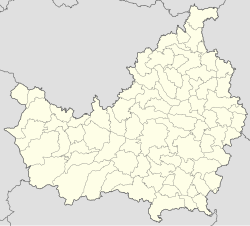| Neolog Synagogue in Cluj-Napoca (Temple of the Deportees) | |
|---|---|
| Romanian: Sinagoga Neologă din Cluj-Napoca | |
 The synagogue, in 2023 The synagogue, in 2023 | |
| Religion | |
| Affiliation | Neolog Judaism |
| Rite | Nusach Ashkenaz |
| Ecclesiastical or organisational status |
|
| Status | Active |
| Location | |
| Location | 21 Horea Street, Cluj-Napoca, Cluj County, Transylvania |
| Country | Romania |
 | |
| Geographic coordinates | 46°46′38″N 23°35′13″E / 46.7771099024°N 23.5868938315°E / 46.7771099024; 23.5868938315 |
| Architecture | |
| Architect(s) | Izidor Hegner |
| Type | Synagogue architecture |
| Style | Moorish Revival |
| Date established | 1849 (as a congregation) |
| Groundbreaking | 1886 |
| Completed | 1887 |
| Demolished | Partially in 1927, 1944 |
| Specifications | |
| Dome(s) | Four (maybe more) |
| Materials | Brick |
The Neolog Synagogue in Cluj-Napoca (Romanian: Sinagoga Neologă din Cluj-Napoca); also known as the Temple of the Deportees (Templul Memorial al Deportaţilor; Hungarian: Kolozsvári Neológ Zsinagóga, Emléktemplom), dedicated to the memory of those deported who were victims of the Holocaust; or more simply, the Neolog Synagogue (Romanian: Sinagoga Neologă), is a Neolog Jewish congregation and synagogue, located at 21 Horea Street, in the city of Cluj-Napoca, in Cluj County, in Transylvania, Romania.
Designed by Izidor Hegner in the Moorish Revival style, the synagogue was completed in 1887.
History
Located on Horea Street, it was built based on the plans of Izidor Hegner, an engineer, between 1886 and 1887. Seriously affected after attacks by the Iron Guard on September 13, 1927, it was soon rebuilt by the Romanian government.
In the period following the Second Vienna Award, when Northern Transylvania was returned to Hungary, it witnessed the Jews' deportation to Nazi extermination camps, Auschwitz-Birkenau, and was damaged by the bombardments of the neighbouring railway station, on June 2, 1944. In 1951 it was again restored, and the synagogue rededicated in memory of the lives of the Jews who were deported during the Holocaust.
In 2018, further restoration of the synagogue commenced including the development of a Jewish social cultural center.
See also

References
- ^ "Neolog Synagogue in Cluj-Napoca". Historic Synagogues of Europe. Foundation for Jewish Heritage and the Center for Jewish Art at the Hebrew University of Jerusalem. n.d. Retrieved August 29, 2024.
- Gyémánt, Ladislau (2010). "Cluj". The YIVO Jewish Encyclopedia of Jews in Eastern Europe. YIVO Institute for Jewish Research. Retrieved August 31, 2024.
- "Romania: the Moorish-style Memorial Synagogue in Cluj (Kolozsvár) is under restoration; a Jewish social & cultural center is also to be developed". Jewish Heritage Europe. October 30, 2018. Retrieved August 31, 2024.
External links
![]() Media related to Neologue Synagogue, Cluj-Napoca at Wikimedia Commons
Media related to Neologue Synagogue, Cluj-Napoca at Wikimedia Commons
- "Cluj-Napoca, Sinagoga neologă" (text and multiple images). Welcome to Romania (in Romanian). 2021.
- www.jewishcluj.eu
| Active |
|
|---|---|
| Former |
|
| Landmarks in Cluj-Napoca | |
|---|---|
| Places of worship | |
| Historical buildings |
|
| Statues and monuments | |
| Sports venues |
|
| Avenues and squares |
|
| Other sites | |
This Cluj County location article is a stub. You can help Misplaced Pages by expanding it. |
This article about a synagogue or other Jewish place of worship in Romania is a stub. You can help Misplaced Pages by expanding it. |
- 1849 establishments in the Austrian Empire
- 19th-century synagogues in Romania
- Ashkenazi Jewish culture in Romania
- Ashkenazi synagogues
- Buildings and structures in Cluj-Napoca
- History of Cluj-Napoca
- Jewish organizations established in 1849
- Moorish Revival architecture in Romania
- Moorish Revival synagogues
- Neolog synagogues in Romania
- Synagogue buildings with domes
- Synagogues completed in 1887
- Cluj County geography stubs
- European synagogue stubs
- Romanian religious building and structure stubs